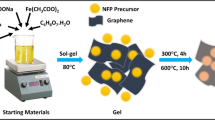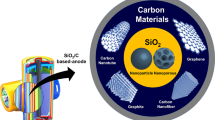Abstract
Silica/silicon/polyacrylonitrile (SiO2/Si/PAN) composites were prepared as active anode for lithium-ion batteries (LIBs) using a rational template method and liquid-phase mixing. The redox graphene (rGO), multi-walled carbon nanotubes (MWCNTs) and their compounds are used as conductive agents. The results show that the addition of MWCNTs can improve the rate performance, while rGO can reduce the charge transfer resistance. Surprisingly, the binary conductive agents prepared by rGO and MWCNTs at the mass ration of 1:1 combined the advantages of both with a first discharge capacity of 3009 mA h g−1 at 0.1 C and a coulombic efficiency of 96%. Here, we demonstrate that SiO2/Si/PAN prepared with a binary conductive agents of equal mass ratio of rGO and MWCNTs can greatly improve the capacity, cycling performance, rate performance and conductivity of LIBs.







Similar content being viewed by others
Data availability
All the data in this paper is true and reliable. Readers can use the materials used in the article for data reproduction, and data such as materials and methods can be shared.
References
C. Gong, Z. Xue, S. Wen, Y. Ye, X. Xie, Advanced carbon materials/olivine LiFePO4 composites cathode for lithium ion batteries. J. Power Sources 318, 93–112 (2016)
N. Nitta, F. Wu, J.T. Lee, G. Yushin, Li-ion battery materials: present and future. Mater. Today 18(5), 252–264 (2015)
S.-W. Park, J.H. Ha, B.W. Cho, H.-J. Choi, Designing of high capacity Si nanosheets anode electrodes for lithium batteries. Surf. Coat. Technol 421, 127358 (2021)
R. Schmuch, R. Wagner, G. Hörpel, T. Placke, M. Winter, Performance and cost of materials for lithium-based rechargeable automotive batteries. Nat. Energy 3(4), 267–278 (2018)
R.E.A. Ardhi, G. Liu, M.X. Tran, C. Hudaya, J.Y. Kim, H. Yu, J.K. Lee, Self-relaxant superelastic matrix derived from C60 incorporated Sn nanoparticles for ultra-high-performance Li-ion batteries. ACS Nano 12(6), 5588–5604 (2018)
J.J. Lodico, C.H. Lai, M. Woodall, H.L. Chan, E. Garcia, W.A. Hubbard, B. Dunn, B.C. Regan, Irreversibility at macromolecular scales in the flake graphite of the lithium-ion battery anode. J Power Sources 436, 226841 (2019)
Y. Fang, Y. Huang, S. Zhang, W. Jia, X. Wang, Y. Guo, D. Jia, L. Wang, Synthesis of unique hierarchical mesoporous layered-cube Mn2O3 by dual-solvent for high-capacity anode material of lithium-ion batteries. Chem. Eng. J. 315, 583–590 (2017)
X. Ma, A.L. Smirnova, H. Fong, Flexible lignin-derived carbon nanofiber substrates functionalized with iron (III) oxide nanoparticles as lithium-ion battery anodes. Mater. Sci. Eng. B 241, 100–104 (2019)
B. Scrosati, J. Hassoun, Y.-K. Sun, Lithium-ion batteries. A look into the future. Energy Environ. Sci 4(9), 3287–3295 (2011)
L. Wei, Z. Hou, High performance polymer binders inspired by chemical finishing of textiles for silicon anodes in lithium ion batteries. J. Mater. Chem. A 5(42), 22156–22162 (2017)
L. Shi, C. Pang, S. Chen, M. Wang, K. Wang, Z. Tan, P. Gao, J. Ren, Y. Huang, H. Peng, Z. Liu, Vertical graphene growth on SiO microparticles for stable lithium ion battery anodes. Nano Lett. 17(6), 3681–3687 (2017)
L. Hou, H. Zheng, R. Cui, Y. Jiang, Q. Li, X. Jiang, J. Gao, F. Gao, Silicon carbon nanohybrids with expandable space: a high-performance lithium battery anodes. Microporous Mesoporous Mater. 275, 42–49 (2019)
C. Yao, X. Li, Y. Deng, Y. Li, P. Yang, S. Zhang, J. Yuan, R. Wang, An efficient prelithiation of graphene oxide nanoribbons wrapping silicon nanoparticles for stable Li+ storage. Carbon 168, 392–403 (2020)
J. Liang, F. Huo, Z. Zhang, W. Yang, M. Javid, Y. Jung, X. Dong, G. Cao, Controlling the phenolic resin-based amorphous carbon content for enhancing cycling stability of Si nanosheets@C anodes for lithium-ion batteries. Appl. Surf. Sci. 476, 1000–1007 (2019)
F. Zhang, X. Yang, Y. Xie, N. Yi, Y. Huang, Y. Chen, Pyrolytic carbon-coated Si nanoparticles on elastic graphene framework as anode materials for high-performance lithium-ion batteries. Carbon 82, 161–167 (2015)
M. Ashuri, Q. He, Y. Liu, K. Zhang, S. Emani, M.S. Sawicki, J.S. Shamie, L.L. Shaw, Hollow silicon nanospheres encapsulated with a thin carbon shell: an electrochemical study. Electrochim. Acta 215, 126–141 (2016)
N. Liu, J. Liu, D. Jia, Y. Huang, J. Luo, X. Mamat, Y. Yu, Y. Dong, G. Hu, Multi-core yolk-shell like mesoporous double carbon-coated silicon nanoparticles as anode materials for lithium-ion batteries. Energy Stor. Mater. 18, 165–173 (2019)
S.-J. Kim, M.-C. Kim, S.-B. Han, G.-H. Lee, H.-S. Choe, S.-H. Moon, D.-H. Kwak, S. Hong, K.-W. Park, 3-D Si/carbon nanofiber as a binder/current collector-free anode for lithium-ion batteries. J. Ind. Eng. Chem. 49, 105–111 (2017)
X. Wei, Y. Guan, X. Zheng, Q. Zhu, J. Shen, N. Qiao, S. Zhou, B. Xu, Improvement on high rate performance of LiFePO4 cathodes using graphene as a conductive agent. Appl. Surf. Sci. 440, 748–754 (2018)
W. Luo, Y. Wang, S. Chou, Y. Xu, W. Li, B. Kong, S.X. Dou, H.K. Liu, J. Yang, Critical thickness of phenolic resin-based carbon interfacial layer for improving long cycling stability of silicon nanoparticle anodes. Nano Energy 27, 255–264 (2016)
Xu Q, Sun J-K, Yin Y-X, Guo Y-G, Facile synthesis of blocky SiOx/C with graphite-like structure for high-performance lithium-ion battery anodes. Adv Funct Mater 28(8), 10. Doi: https://doi.org/10.1002/adfm.201705235 (2018)
R. Zhou, H. Guo, Y. Yang, Z. Wang, X. Li, Y. Zhou, N-doped carbon layer derived from polydopamine to improve the electrochemical performance of spray-dried Si/graphite composite anode material for lithium ion batteries. J. Alloy Compd 689, 130–137 (2016)
Z. Yan, J. Jiang, Y. Zhang, D. Yang, N. Du, Scalable and low-cost synthesis of porous silicon nanoparticles as high-performance lithium-ion battery anode. Mater. Today Nano 18, Article ID 00175 (2022)
P.R. Ilango, R. Gnanamuthu, Y.N. Jo, C.W. Lee, Design and electrochemical investigation of a novel graphene oxide-silver joint conductive agent on LiFePO4 cathodes in rechargeable lithium-ion batteries. Ind. Eng. Chem. 36, 121–124 (2016)
X. Kong, S. Peng, J. Li, Z. Chen, Z. Chen, J. Wang, J. Zhao, Pre-blended conductive agent to effectively improve the storage properties of LiNi0.6Co0.2Mn0.2O2 cathode materials. J. Power Sources 448, 227 (2020)
F. Wang, F. Wang, R. Hong, X. Lv, Y. Zheng, H. Chen, High-purity few-layer graphene from plasma pyrolysis of methane as conductive additive for LiFePO4 lithium ion battery. J. Mater. Res. Technol. 9(5), 10004–10015 (2020)
Q. Wang, F.-Y. Su, Z.-Y. Tang, G.-W. Ling, Q.-H. Yang, Synergetic effect of conductive additives on the performance of high power lithium ion batteries. New Carbon Mater 27(6), 427–432 (2012)
H. Chen, H. Zhang, Y. Wu, T. Zhang, Y. Guo, Q. Zhang, Y. Zeng, J. Lu, Nanostructured Nb2O5 cathode for high-performance lithium-ion battery with Super-P and graphene compound conductive agents. J. Electroanal. Chem 827, 112–119 (2018)
M. Marinaro, F. Nobili, R. Tossici, R. Marassi, Microwave-assisted synthesis of carbon (Super-P) supported copper nanoparticles as conductive agent for Li4Ti5O12 anodes for Lithium-ion batteries. Electrochim. Acta 89, 555–560 (2013)
S. Xi, P. Zhang, Y. Huang, M. Kong, Q. Yang, G. Li, Laser sintering of cryogenically ground polymer powders into high-performance parts: the role of dry particle coating with a conductive flow agent. Polymer 186, 102044 (2020)
M Handayani, M Ganta, D N A Susilo, M S Yahya, G K Sunnardianto, N Darsono, E Sulistiyono, I Setiawan, F P Lestari, A Erryani, Synthesis of graphene oxide from used electrode graphite with controlled oxidation process. IOP Conf. Ser: Mater Sci Eng 541, (2019)
S. Park, J. An, J.R. Potts, A. Velamakanni, S. Murali, R.S. Ruoff, Hydrazine-reduction of graphite- and graphene oxide. Carbon 49(9), 3019–3023 (2011)
L. Li, S. Luo, Z. Zheng, K. Zhong, W. Huang, Z. Fang, Litchi shell-derived porous carbon for enhanced stability of silicon-based lithium-ion battery anode materials. Ionics 28(1), 161–172 (2021)
Acknowledgements
This research was supported by a grant from the National Natural Science Foundation of China (Nos. 61504080 and 61704107), the Young Eastern Scholar (QD2016012) of Shanghai Municipal Education Commission and Shanghai Pujiang Program (17PJ1406800).
Author information
Authors and Affiliations
Contributions
All authors contributed to the conception and design of the research. The research direction and the design of the experimental process were jointly completed by Professor XL, YX and QL, The collection of materials, data collation and the preparation of the first draft were all completed by WC and XL. All authors read and approved the final draft.
Corresponding author
Ethics declarations
Conflict of interest
All authors hereby solemnly declare that there is no conflict of interest in submitting this manuscript and that the manuscript has been approved for publication by all authors. The work described is original research that has not been published before and has not yet been considered for publication in whole or in part elsewhere.
Additional information
Publisher's Note
Springer Nature remains neutral with regard to jurisdictional claims in published maps and institutional affiliations.
Rights and permissions
Springer Nature or its licensor holds exclusive rights to this article under a publishing agreement with the author(s) or other rightsholder(s); author self-archiving of the accepted manuscript version of this article is solely governed by the terms of such publishing agreement and applicable law.
About this article
Cite this article
Liu, X., Chen, W., Xia, Y. et al. Improved electrochemical performance of silicon-carbon anodes by different conductive agents. J Mater Sci: Mater Electron 33, 21311–21320 (2022). https://doi.org/10.1007/s10854-022-08920-4
Received:
Accepted:
Published:
Issue Date:
DOI: https://doi.org/10.1007/s10854-022-08920-4




